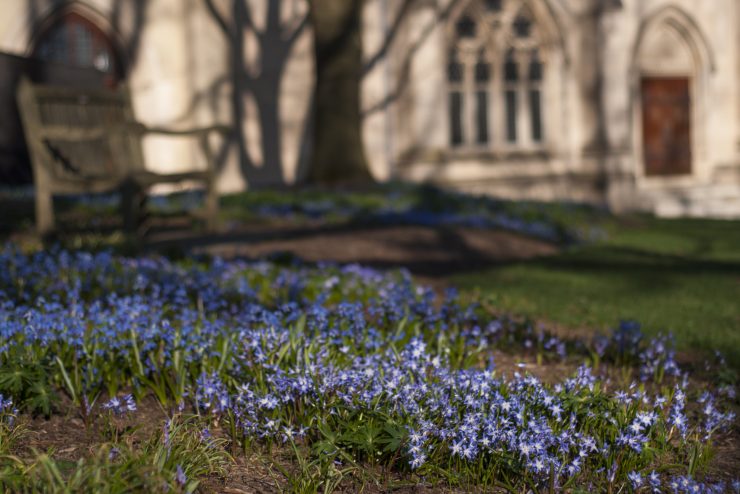Judith Mayotte

“Remember you are dust and to dust you will return.” Remember! Reflect! “Come back to me with all your heart,” our loving God calls out to us, for the dust of our being is stardust. In this season of gestation and germination that anticipates and pushes upward toward new life from the soil of Mother Earth, we are offered the opportunity to reset our connection to and interdependence with our God, each other and the whole of creation. As we contemplate breaches in our relationship with God, our neighbors and Mother Earth, we ask anew what the covenantal mandate to “love God with all our hearts and our neighbors as ourselves” asks of us. Wrapped as we are together in the “bundle of life.” (Desmond Tutu, No Future Without Forgiveness), we live together on a spinning planet in the Holocene Age that has produced a Goldilocks home, just right for life as we know it to thrive and flourish. Loving God, our neighbors and our Earth home ask that we humans be good stewards, caring for the whole of creation.
We humans are late-comers—even billions of years spanning between the appearance and unfolding of life on earth and the appearance of Homo sapiens. When we ask how we are doing in maintaining our stable Holocene state, we need to acknowledge that as care-givers, as stewards, of our finite and fragile planet, humans are found wanting. In this digital, highly technological, globalized world of ours, we humans have become such a force in and on nature that we are changing our climate and the environment to the detriment of all creation. We are breaching our “planetary boundaries,” impacting Earth’s ecosystems, as Joseph Rockstrom (Big World, Small Planet: Abundance Within Planetary Boundaries) notes. Our historical time is coming to be known as the Anthropocene and the Age of the Sixth Mass Extinction, for we humans, through our activities, through our overuse of earth’s finite resources and increasing emissions of greenhouse gases into earth’s atmosphere, have become the single dominant geophysical force in altering the natural world. And we humans are bringing about this change at a speed and a scale which author Diane Ackerman likens to an asteroid slamming into the earth. (The Human Age: The World Shaped By Us)
Today, our human footprint is much larger than the global ecosystem can accommodate. We are living beyond the ecological capacity of the earth to continue to carry, nourish and enable humans and all of creation to flourish. Pope Francis in his powerful encyclical Laudato si calls our generation to build a culture that will face and address our ecological crisis, a culture that will “hear the cry of the earth and the cry of the poor.” (Paragraph 49) Francis reminds us that the climate is a complex system and a common good, belonging to all, meant for all and needed by all for life to flourish. (Paragraph 23) Everything we see around us comes from nature—from the carrots we eat to the cell phones that keep us in touch with those we love. Nature is the source of our wealth and wellbeing. And all is interconnected and interdependent in this mysterious web of life.
We chafe at boundaries, rules, and regulations. Yet, boundaries don’t have to tie us down. Truly, they offer opportunities. I think of my favorite tennis player Roger Federer. Why is he such a great player? Certainly it is not because he hits a tennis ball like a baseball player hitting the ball out of the park. That does not work in tennis. He is great because he stays within the boundaries set by lines and court areas. Only by playing within the designated boundaries does he remain the great player he is to this day. I think, too, of two highways that offer breathtaking views. The first is one of the highest highways in the world, the Karakorum, which ascends from Abbottabad in Pakistan through some of the world’s highest and most magnificent peaks and on into China. Its two lanes are often rock strewn from frequent slides, causing the driver to veer close to the edge that drops thousands of feet into rushing river waters below. At the time I traveled on the Karakorum Highway, there were no guardrails. One feels the peril of the drive. The beautiful vistas the second offers can be more easily relished, for along the fine road of the Garden Route of the Western Cape in South Africa, guardrails offer great assurance. Safely from the car windows, one can enjoy looking out over the area where the Atlantic and Indian Oceans converge and where porpoises dance and whales playfully leap.
Lent is not an idle time. Lent is a moment of choice of how we live out the greatest commandment to love God, our neighbors, and Mother Earth as we love ourselves. Love of God and neighbor encompasses loving and caring for the whole of creation through small, simple acts as well as momentous ones. Living within our planetary boundaries affords us the opportunity to make positive choices for building and creating the kind of world that at the same time maintains a resilient and stable Earth home. We have the technology, knowledge and creative imaginations to act collectively in creating a world in which all creation can thrive and flourish. Let us live Lent’s movement toward resurrection, the time for lovingly making all things new.